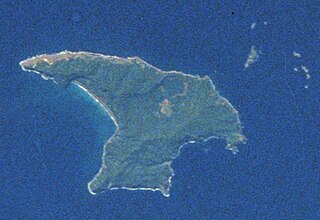
Raoul Island, the largest and northernmost of the main Kermadec Islands, 900 km (560 mi) south south-west of 'Ata Island of Tonga and 1,100 km (680 mi) north north-east of New Zealand's North Island, has been the source of vigorous volcanic activity during the past several thousand years that was dominated by dacitic explosive eruptions.

Rhopalostylis is a genus of two species of palms native to the South Pacific. Both are smooth-trunked, with regular ringed scars from fallen leaves. The leaves are 3–5 m in length, and the leaf bases encircle the trunk.
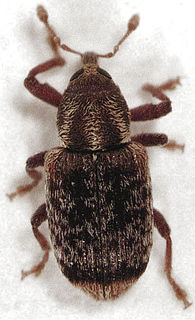
Peristoreus is a weevil genus native to New Zealand. This genus was first described in 1877 by Theodor Franz Wilhelm Kirsch.
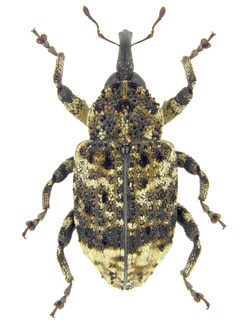
Cryptorhynchinae is a large subfamily of weevils (Curculionidae), with some 6000 species. They are found in most zoogeographic regions although they are most diverse in the Neotropics, Australia and Oceania.

Mecodema is a genus of large flightless ground beetle (Carabidae) endemic to New Zealand. The genus is very diverse in comparison to the other three New Zealand genera within the subtribe Nothobroscina. Mecodema is geographically widespread across both the North and South Islands, as well as numerous offshore islands, including the Three Kings Is., Poor Knights Is., Aotea and Hauturu, Kapiti Is., Stephens Is., Stewart Is., Chatham Is., Snares Is.

Hadramphus, commonly known as knobbled weevils, is a genus of flightless molytine weevils from the family Curculionidae. It is endemic to New Zealand and consists of four species.

Chaetosomatidae is a small family of beetles, in the superfamily Cleroidea. There are three extant genera, two of which are endemic to New Zealand with the other (Malgassochaetus) native to Madagascar. Members of this family are predaceous on wood-boring insects.
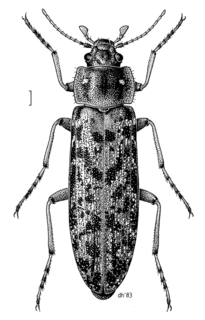
The Chalcodryidae are a family of beetles in the superfamily Tenebrionoidea. It contains at least five species in two genera Chalcodrya and Philpottia, which are endemic to New Zealand. They are generally found associated with moss or lichen covered branches, with the larvae having been found to be associated with dead twigs. It is thought that they are noctural, feeding on lichen and other plant material at night. The genera Sirrhas and Onysius, formerly placed in this family, have subsequently been transferred to Promecheilidae.
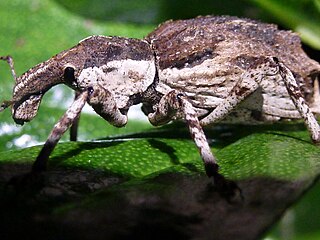
Anagotus stephenensis, commonly known as the ngaio weevil, is a large flightless weevil that is only found on Stephens Island in New Zealand. The ngaio weevil was discovered in 1916 by A.C. O'Connor on Stephens Island. Thomas Broun described it in 1921 as Phaeophanus oconnori after its collector. The weevils were observed at the time to be 'feeding on tall fescue and the leaves of trees'.

Eurynotia is a weevil genus in the tribe Tropiphorini.
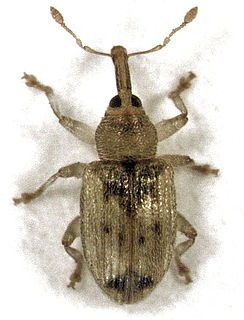
Peristoreus stramineus is a species of true weevil. It is endemic to New Zealand. The larvae develop in flower buds of Hoheria populnea.

Peristoreus fulvus is a species of true weevil. It is endemic to New Zealand. It is associated with plants of the genus Muehlenbeckia.
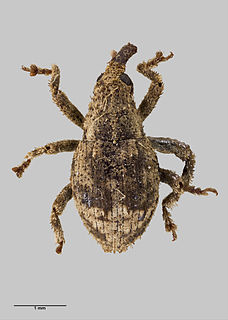
Didymus is a genus of beetles known as weevils. The genus contains the following species:
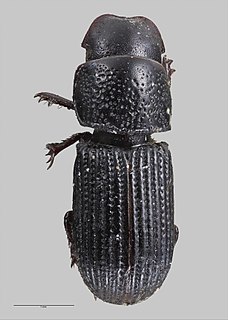
Saprosites raoulensis is a species of dung beetle endemic to the Kermadec Islands in New Zealand. The holotype specimen of this species was discovered during a scientific expedition to the Kermadecs by W. L. Wallace in 1908. It was found under rotten logs on Raoul Island.
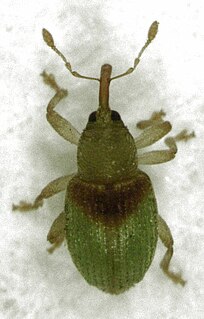
Peristoreus viridipennis is a species of true weevil. It is endemic to New Zealand. It is associated with plants of the genus Muehlenbeckia.
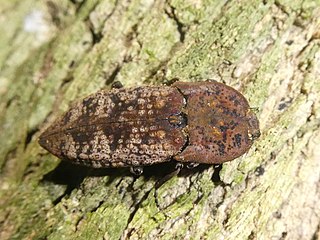
Amychus granulatus, commonly known as the Cook Strait click beetle, is a large flightless click beetle in the family Elateridae.

Kenocoelus is a genus of rove beetles containing a number of species, all endemic to New Zealand. It is part of the Trichonychini tribe, in the Pselaphinae subfamily of Staphylinidae.

Helmoreus is a genus of fungus weevil which was circumscribed by the New Zealand entomologist Beverley Holloway in 1982. The generic name honors the scientific illustrator Des Helmore. It is found in New Zealand, Australia, and New Caledonia. It is in the tribe Stenocerini.


















